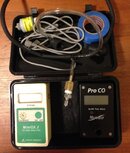Hatul
Contributor
Communication device that uses ultrasound and looks like a Blackberry with a keyboard but doable with gloves. It could have preprogrammed macros so common phrases can be easily entered. It would also tell you the direction to your buddy.





